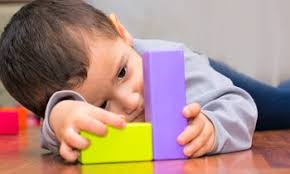The following are considered “red flags” that may indicate a child is at risk for an autism spectrum disorder.
• No big smiles or other warm, joyful expressions by six months or thereafter
• No back-and-forth sharing of sounds, smiles or other facial expressions by nine months
• No babbling by 12 months
• No back-and-forth gestures such as pointing, showing, reaching or waving by 12 months
• No words by 16 months
• No meaningful, two-word phrases (not including imitating or repeating) by 24 months
• Any loss of speech, babbling or social skills at any age
Developmental milestones provide important guidelines for tracking healthy development from four months to three years of age. Parents are encouraged to take the time to see if their child has met his/her key milestones. If not, or if a child loses a previously developed skill at any age, parents should seek a consult.
By 3-4 months
• Watches faces with interest and follows moving objects
• Recognizes familiar objects and people; smiles at the sound of your voice
• Begins to develop a social smile
• Turns head toward sounds
By 7 Months
• Responds to other people’s emotions
• Enjoys face-to-face play; can find partially hidden objects
• Explores with hands and mouth; struggles for out of reach objects
• Responds to own name
• Uses voice to express joy and displeasure; babbles chains of sounds
By 12 Months/1 Year
• Enjoys imitating people; tries to imitate sounds
• Enjoys simple social games, such as “I’m gonna get you!”
• Explores objects; finds hidden objects
• Responds to “no;” uses simple gestures, such as pointing to an object
• Babbles with changes in tone; may use single words (“dada,”“mama,” “Uh-oh!”)
• Turns to person speaking when his/her name is called
By 24 Months/2 Years
• Imitates behavior of others; is excited about company of other children
• Understands several words
• Finds deeply hidden objects; points to named pictures and objects
• Begins to sort by shapes and colors; begins simple make-believe play
• Recognizes names of familiar people and objects; follows simple instructions
• Combines two words to communicate with others, such as “more cookie?”
By 36 Months/3 Years
• Expresses affection openly and has a wide range of emotions
• Makes mechanical toys work; plays make-believe
• Sorts objects by shape and color, matches objects to pictures
• Follows a 2- or 3-part command; uses simple phrases to communicate with others, such as “go outside, swing?”
• Uses pronouns (I, you, me) and some plurals (cars, dogs)
By 48 Months/4 Years
• Cooperates with other children; is increasingly inventive in fantasy play
• Names some colors; understands concepts of counting and time
• Speaks in sentences of five to six words
• Tells stories; speaks clearly enough for strangers to understand
• Follows three-part commands; understands “same” and “different”
By 60 Months/5 Years
• Wants to be like his/her friends; likes to sing, dance, and act
• Is able to distinguish fantasy from reality
• Shows increased independence
• Can count 10 or more objects and correctly name at least four colors
• Speaks in sentences of more than five words; tells longer stories

